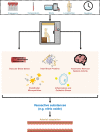Effect of heat stress on vascular outcomes in humans
- PMID: 30676869
- PMCID: PMC6459390
- DOI: 10.1152/japplphysiol.00682.2018
Effect of heat stress on vascular outcomes in humans
Abstract
In addition to its role as an environmental stressor, scientists have recently demonstrated the potential for heat to be a therapy for improving or mitigating declines in arterial health. Many studies at both ends of the scientific controls spectrum (tightly controlled, experimental vs. practical) have demonstrated the beneficial effects of heating on microvascular function (e.g., reactive hyperemia, cutaneous vascular conductance); endothelial function (e.g., flow-mediated dilation); and arterial stiffness (e.g., pulse-wave velocity, compliance, β-stiffness index). It is important to note that findings of beneficial effects are not unanimous, likely owing to the varied methodology in both heating protocols and assessments of outcome measures. Mechanisms of action for the effects of both acute and chronic heating are also understudied. Heat science is a very promising area of human physiology research, as it has the potential to contribute to approaches addressing the global cardiovascular disease burden, particularly in aging and at risk populations, and those for whom exercise is not feasible or recommended.
Keywords: arterial stiffness; endothelial function; heat stress; heat therapy; vascular physiology.
Conflict of interest statement
No conflicts of interest, financial or otherwise, are declared by the authors.
Figures



Similar articles
-
Acute effects of different types of aerobic exercise on endothelial function and arterial stiffness.Eur J Prev Cardiol. 2016 Sep;23(14):1565-72. doi: 10.1177/2047487316647185. Epub 2016 Apr 27. Eur J Prev Cardiol. 2016. PMID: 27121699 Clinical Trial.
-
Acute heat stress reduces biomarkers of endothelial activation but not macro- or microvascular dysfunction in cervical spinal cord injury.Am J Physiol Heart Circ Physiol. 2019 Mar 1;316(3):H722-H733. doi: 10.1152/ajpheart.00693.2018. Epub 2018 Dec 21. Am J Physiol Heart Circ Physiol. 2019. PMID: 30575438 Free PMC article.
-
Exercise-induced heat stress disrupts the shear-dilatory relationship.Exp Physiol. 2016 Dec 1;101(12):1541-1551. doi: 10.1113/EP085828. Epub 2016 Oct 25. Exp Physiol. 2016. PMID: 27647442
-
Between Rho(k) and a hard place: the relation between vessel wall stiffness, endothelial contractility, and cardiovascular disease.Circ Res. 2015 Feb 27;116(5):895-908. doi: 10.1161/CIRCRESAHA.116.305720. Circ Res. 2015. PMID: 25722443 Review.
-
Arterial stiffness, atherosclerosis and cardiovascular risk: Pathophysiologic mechanisms and emerging clinical indications.Vascul Pharmacol. 2016 Feb;77:1-7. doi: 10.1016/j.vph.2015.11.083. Epub 2015 Nov 28. Vascul Pharmacol. 2016. PMID: 26643779 Review.
Cited by
-
Cardiovascular physiological effects of balneotherapy: focused on seasonal differences.Hypertens Res. 2023 Jul;46(7):1650-1661. doi: 10.1038/s41440-023-01248-4. Epub 2023 Mar 29. Hypertens Res. 2023. PMID: 36991066 Free PMC article.
-
DNAJA1‑knockout alleviates heat stroke‑induced endothelial barrier disruption via improving thermal tolerance and suppressing the MLCK‑MLC signaling pathway.Mol Med Rep. 2024 May;29(5):87. doi: 10.3892/mmr.2024.13211. Epub 2024 Mar 29. Mol Med Rep. 2024. PMID: 38551163 Free PMC article.
-
The impact of repeated, local heating-induced increases in blood flow on lower limb endothelial function in young, healthy females.Eur J Appl Physiol. 2021 Nov;121(11):3017-3030. doi: 10.1007/s00421-021-04749-7. Epub 2021 Jul 12. Eur J Appl Physiol. 2021. PMID: 34251539
-
The Effects of Local Heating on Facilitating Radial Angiography: A Randomized Controlled Trial.Iran J Nurs Midwifery Res. 2024 Nov 20;29(6):685-690. doi: 10.4103/ijnmr.ijnmr_181_22. eCollection 2024 Nov-Dec. Iran J Nurs Midwifery Res. 2024. PMID: 39759923 Free PMC article.
-
Intradialytic Hypotension: Mechanisms and Outcome.Blood Purif. 2020;49(1-2):158-167. doi: 10.1159/000503776. Epub 2019 Dec 18. Blood Purif. 2020. PMID: 31851975 Free PMC article. Review.
References
Publication types
MeSH terms
LinkOut - more resources
Full Text Sources
Other Literature Sources
Medical

